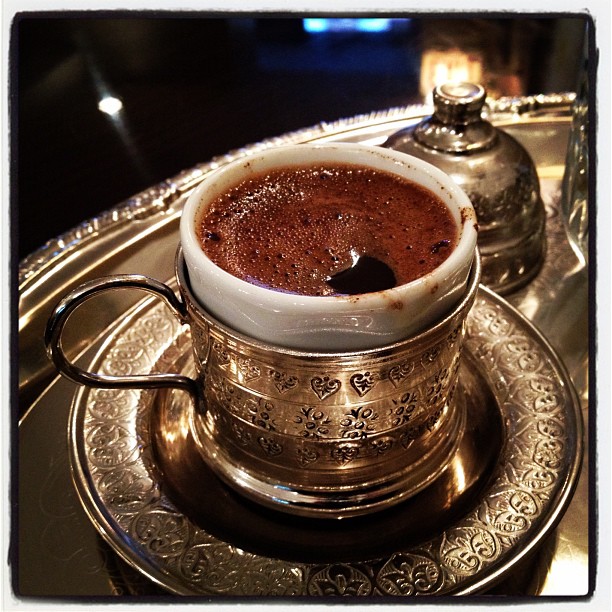Drinking thick and flavorful Turkish coffee in Istanbul is one of the delights of visiting this bridge between East and West. In this article we take a look at the history of Turkish coffee, give some recommendations where to drink it in Istanbul, and suggest some delicious snacks to sample on the side.
A Short History of Turkish Coffee
Since the 15th century, people have been enjoying coffee for its spirit lifting properties. Though the first coffee beans were probably picked, roasted and ground in Yemen, near the port city of Mokha, traveling merchants and other adventurers soon brought the tradition of drinking coffee to other nearby areas. By the 1600s, the Istanbul elite were able to sip java in two coffeehouses in the city and began brewing it at home.
Turkish coffee is notably different from other styles of coffee in a few ways. To begin with, it’s served in very small cups, which can be strange for some North American travelers used to full mugs of joe. A second difference is that you won’t be able to drink your coffee in a quick swig, as you would an Italian-style espresso. This sipping coffee has grounds at the bottom of the cup, so you’ll want to drink carefully as you approach the last of your drink. And lastly, make sure when you order your coffee to specify the amount of sugar you desire. The coffee shop staff adds sugar to the coffee during the brewing process so you will not be able to adjust the level of sweetness later.
Unlike the European methods of brewing coffee, mostly influenced by the Italian methods, in Turkey coffee lovers created their own ritual for their morning beverage. Turkish coffee can be brewed with any kind of bean; it’s the method of preparing it that makes it traditionally Turkish.
Brewing the Perfect Cup
To create a cup of Turkish coffee, first grind the beans into a fine powder, finer even than for Italian-style espresso. To get the finest grind, Turkish coffee aficionados swear by hand grinders or burr mills. Next, coffee and sugar are put into warm water and brought to a boil. Traditionally, this is done in a cevze, a tapered pot made of brass or copper with a pouring edge and a long handle on the right side. The mixture can be stirred now, but shouldn’t be later. Then, on moderate heat, bring the coffee to a boil once more. Remove from heat for a short time, and then boil for a third and fourth time. After its brewed, it should have thick foam on the top once it is poured into individual cups.
This foam is considered to be essential to a perfect cup of Turkish coffee.
Popular Cafes in Istanbul
Mandabatmaz is located on Istiklal, near St. Antoine Cathedral. Another place to look for a great cup of Turkish coffee in a traditional setting is a café around the corner from the Grand Bazaar at Çorluoglu Alipasa Medresesi. This café has no name, but smoking water pipes while sipping its thick-foamed coffee is a top-reviewed activity according to travelers. Another at the Grand Bazaar is Kahveci Ethem Tezçakar, a small, family-run shop that has been in business for more than 100 years.
Another area to find great Turkish coffee in Istanbul is Kadıköy, which faces the European side of the city across the Bosphorous. There are many cafes here to try, notably Fazıl Bey Kahvesi and the coffee shops near it.
Flavors to Pair with a Turkish Brew
What to nibble while you sip your foamy coffee? Turkish delight, of course. Baked goods such as baklava or lemony şekerpare are also good complements. However, if your sweet tooth is already on overload because of the sugared coffee, you might choose an accompaniment of a different kind—smoking flavored tobacco from a nargile, or water pipe. The area of Tophane is a popular place for relaxing at an outdoors nargile café, sipping coffee and watching passersby.
Photo credit: coffee
About the Author: Louise Vinciguerra is originally from Brooklyn. When she’s not on Facebook, WordPress or Twitter, she’s traveling in search of fun food and planning trips around her resident city of Rome.

Leave a Reply